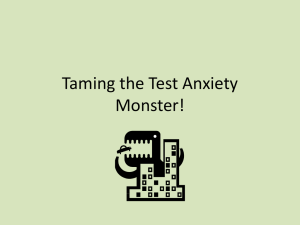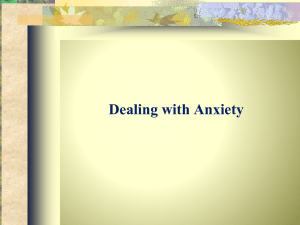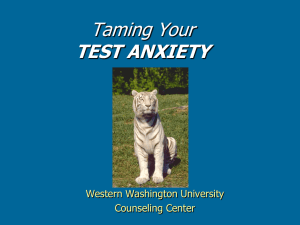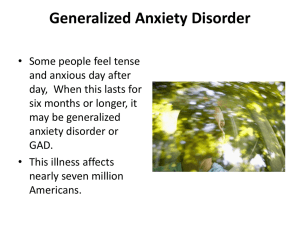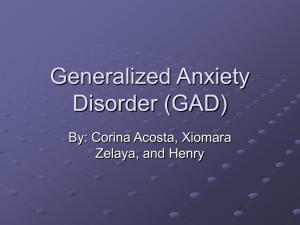Document 5433369
advertisement
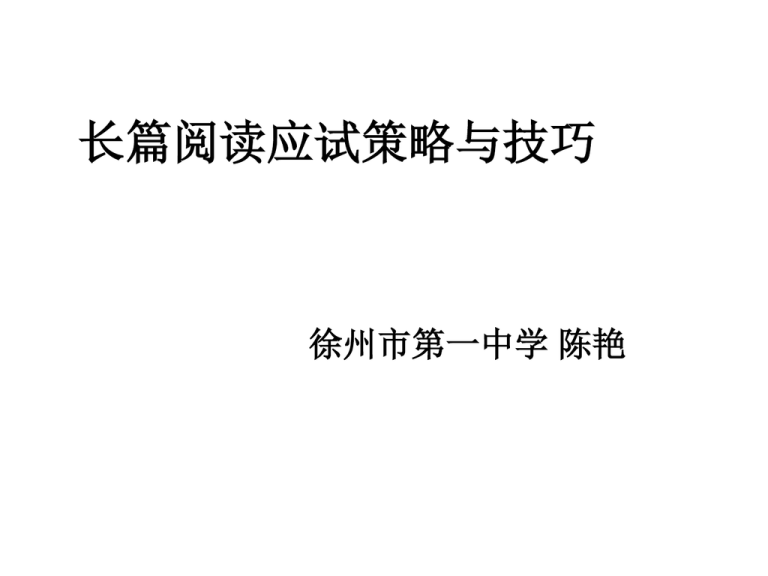
长篇阅读应试策略与技巧 徐州市第一中学 陈艳 2011---2013年阅读理解长度 总词数 A篇 B篇 C篇 D篇 2011 1622 309 323 390 600 2012 1698 307 402 428 561 2013 1866 364 393 437 672 调查问卷结果 长篇难 篇幅太长,读不下去 生词多 话题不熟悉 要点多,结构拎不清 主旨要义不清楚 考试说明阅读理解部分要求: 1. 理解语篇主旨要义 5. 理解文章的基本结构和文脉逻辑关系 体现了对语篇整体和层次把握能力的重视 Aims: 1. 理解段内和段间的逻辑关系。 2. 找出每段的主题句或关键词。 3. 应用相关策略阅读文章。 The linking words within a para: Example: The programme has several aims: first, to help unemployed people find work; second, to teach new mothers about nutrition; and third, to help young people develop problem—sovling skills. Exercise 1----6 The linking words between paras: Example: passage A Conclusion 1: 展现段落之间逻辑关系的关联词语通常出现在段首 Conclusion 2: 每段的主题句常常出现在第一句或最后一句。 Para1:the question of students’ part-time jobs Para2: the first point… useful experience Para3: another argument…financial assistance Para4: one further thing…fun… and useful Para5: in conclusion…fun and part-time jobs could be balanced p1 Beginning para p2 p3 p5 p4 Body paras Concluding para 5. what is the attitude of the author towards students’ part-time jobs? A.positive B. negative How to grasp the main idea of a passage? 1. Pay attention to the linking words within and between paras. 2. Focus on the first and last paras; and the first and last sentences in each para. Almost everyone has experienced anxiety at some time in their lives, and to do so is not only natural, but probably quite sensible, too. In some sense, the feeling of anxiety is like a signal to us that we need to take action. If we are walking alone down a dark street and start to feel anxious, we might think, “This is getting frightening, I think I’ll nip into the pub and call a cab”, so we will be doing something to get ourselves somewhere safe. If we have an exam coming up, we are likely to start feeling anxious. We might think: “It’s no use; I can’t pretend it’s not happening. I’ve got to revise or I’ll totally mess up.” Once again, anxiety can guide us to behave in a way that is in our best interests. However, anxiety can also imprison us. It stops us from doing what we would like to do and living our life fully. Feeling anxious is undoubtedly a fact of life, so our goal is not to live an anxiety-free life — for one thing, nobody ever does; and for another, anxiety can be useful — but to live our life with acceptable levels of anxiety in a full and rich way. Anxiety can be abnormal when it starts to take over our thinking processes and our lives,and makes it difficult for us to function. It is likely that people who experience extreme and upsetting levels of continual anxiety are suffering from a disorder called Generalised Anxiety Disorder or GAD(强迫症). The most important feature of GAD is that people experience quite severe anxiety and worry about a wide range of things over long periods of time. Other symptoms include finding it difficult to control the worry; getting easily tired; difficulty concentrating, or feeling that your mind has gone blank; tension in the muscles; sleep disturbance, so that we have difficulty falling or staying asleep, or wake up feeling unrefreshed by our sleep; finding it difficult to function normally at home, at work, or elsewhere, because of the extent of the worry. People with GAD tend to worry about the same kinds of things as people without GAD — only they fall into worrying more easily and tend to spend more time worrying. Research suggests that our worry tends to cluster(聚集) around particular themes including our health, finances, relationships, family, work and finally, worry about worrying. Some worries are realistic (“real event” worries) and need to be dealt with using problem-solving techniques or finding practical solutions to the problem. For example, if I worry about the size of my credit card bill, then this problem exists and my worry is based on a real and present problem. Some worries are about things that may never happen(“hypothetical event” worries). Sometimes, real event worries spiral into hypothetical event worries. For example, “My neighbors are noisy” could spiral into “I’ll never be able to sell the house, I’ll be stuck here for ever.” Even though you may always have had a tendency to worry — maybe your parents did, too — you can still learn to understand it and get on top of it. Extreme worry is not a part of your personality, and it’s not something that you should accept as unavoidable. Almost everyone has experienced anxiety at some time in their lives, and to do so is not only natural, but probably quite sensible, too. In some sense, the feeling of anxiety is like a signal to us that we need to take action. If we are walking alone down a dark street and start to feel anxious, we might think, “This is getting frightening, I think I’ll nip into the pub and call a cab”, so we will be doing something to get ourselves somewhere safe. If we have an exam coming up, we are likely to start feeling anxious. We might think: “It’s no use; I can’t pretend it’s not happening. I’ve got to revise or I’ll totally mess up.” Once again, anxiety can guide us to behave in a way that is in our best interests. However, anxiety can also imprison us. It stops us from doing what we would like to do and living our life fully. Feeling anxious is undoubtedly a fact of life, so our goal is not to live an anxiety-free life — for one thing, nobody ever does; and for another, anxiety can be useful — but to live our life with acceptable levels of anxiety in a full and rich way. Anxiety can be abnormal when it starts to take over our thinking processes and our lives,and makes it difficult for us to function. It is likely that people who experience extreme and upsetting levels of continual anxiety are suffering from a disorder called Generalised Anxiety Disorder or GAD(强迫症). The most important feature of GAD is that people experience quite severe anxiety and worry about a wide range of things over long periods of time. Other symptoms include finding it difficult to control the worry; getting easily tired; difficulty concentrating, or feeling that your mind has gone blank; tension in the muscles; sleep disturbance, so that we have difficulty falling or staying asleep, or wake up feeling unrefreshed by our sleep; finding it difficult to function normally at home, at work, or elsewhere, because of the extent of the worry. People with GAD tend to worry about the same kinds of things as people without GAD — only they fall into worrying more easily and tend to spend more time worrying. Research suggests that our worry tends to cluster(聚集) around particular themes including our health, finances, relationships, family, work and finally, worry about worrying. Some worries are realistic (“real event” worries) and need to be dealt with using problem-solving techniques or finding practical solutions to the problem. For example, if I worry about the size of my credit card bill, then this problem exists and my worry is based on a real and present problem. Some worries are about things that may never happen(“hypothetical event” worries). Sometimes, real event worries spiral into hypothetical event worries. For example, “My neighbors are noisy” could spiral into “I’ll never be able to sell the house, I’ll be stuck here for ever.” Even though you may always have had a tendency to worry — maybe your parents did, too — you can still learn to understand it and get on top of it. Extreme worry is not a part of your personality, and it’s not something that you should accept as unavoidable. Exercise: passage B Group 1&2 Part A Group 3&4 Part B Group 5 Part C 1. Each group focus on your own tasks given to you on the paper. 2. For each group you need two members to come to the front together and report your answers. Part A: 1. 划出每段的主题句。 2. 猜测本部分之前的内容并陈述理由。 Para1: Anxiety can also imprison(禁锢) us. Para2: Anxiety can be abnormal… GAD (强迫症) Para3: The most important feature of GAD is that… Other symptoms include… Benefits/ positive sides of anxiety Part B: 1. 划出每段的主题句。 2. 猜测本部分之前的内容,选择答案并陈述理由。 A. people without GAD B. what is GAD and the symptoms Para1: People with GAD fall into worrying more easily and tend to spend more time worrying. Para2: some worries are realistic, some are about things that may never happen Part C: 1. 划出每段的主题句。 2. 猜测文章主体部分内容并陈述理由。 Para1: Everyone has experienced anxiety and to do so is not only natural, but quite sensible, too. that is, positive sides of anxiety Para2: you can learn to understand anxiety and get on top of it. Negative sides of anxiety Part A: Para1: Anxiety can also imprison(禁锢) us. Para2: Anxiety can be abnormal …GAD (强迫症) Para3: The most important feature of GAD is that… Other symptoms include… Part B: Para1: People with GAD fall into worrying more easily and tend to spend more time worrying. Para2: some worries are realistic, some are about things that may never happen Part C: Para1: Everyone has experienced anxiety and to do so is not only natural, but quite sensible, too. Para2: You can learn to understand anxiety and get on top of it. Almost everyone has experienced anxiety ...... However, anxiety can also imprison(禁锢) us. Anxiety can be abnormal …… The most important feature of GAD …… People with GAD(强迫症) tend to worry about …… Some worries are realistic…… Some worries are about things that may never happen…… Even though you may always have had a tendency to worry … 1. 阅读文章完成练习。 2. 讨论并核对答案。 3. 解释答案提供理由。 2.Which would be the best title of the passage? A. Anxiety:Learn to Understand It B. GAD: Learn to Keep Away from It C. How to Get Rid of Your Anxiety D. How to Distinguish Anxiety from GAD 3. It can be inferred from the passage that ___________. A. GAD can hardly be cured once one suffers from it B. anxiety actually has both positive and negative sides C. most people have experienced different levels of GAD D. hypothetical event worries are mostly from real event worries Conclusion: 1. what methods have we discussed today to get the main idea or the structure of a passage? ①Pay attention to the linking words within and between paras. ②Focus on the first and last paras; the first and last sentences in each para. Conclusion: 2. 除了方法,阅读长篇文章时还应注意哪些方面? ① 静下心来,不要过于焦虑。 ②先看问题,再看文章。 ③扩大词汇量。 ④扩大阅读量,拓宽知识面,训练速度和耐心。 Homework: Finish passage C using the strategies we learnt today.

